This weekend was the first of a two part CAP (Creative Articulation Process) workshop in Siobhan Davis Studio, London, on 20-21 January 2024.
“CAP is the process of bringing the inner experiences to the outer through language” (See details about CAP at the end of this post)
DAY ONE
Dual Attending
The tasks were reflective, attending to the sensory process of making small movements and ‘Dual Attending’. We were asked to slow down, allow time, come back to the body, experience the language of the body before verbalising it, experience the ‘felt sense’ as used by Antonio Damasio and tracking the impulses that arise and follow them, and coming to the notion that ‘I have a body’ and ‘I know my body’. We then used our own way of articulating the feelings in mark-making/words, etc. See CAP-Image1
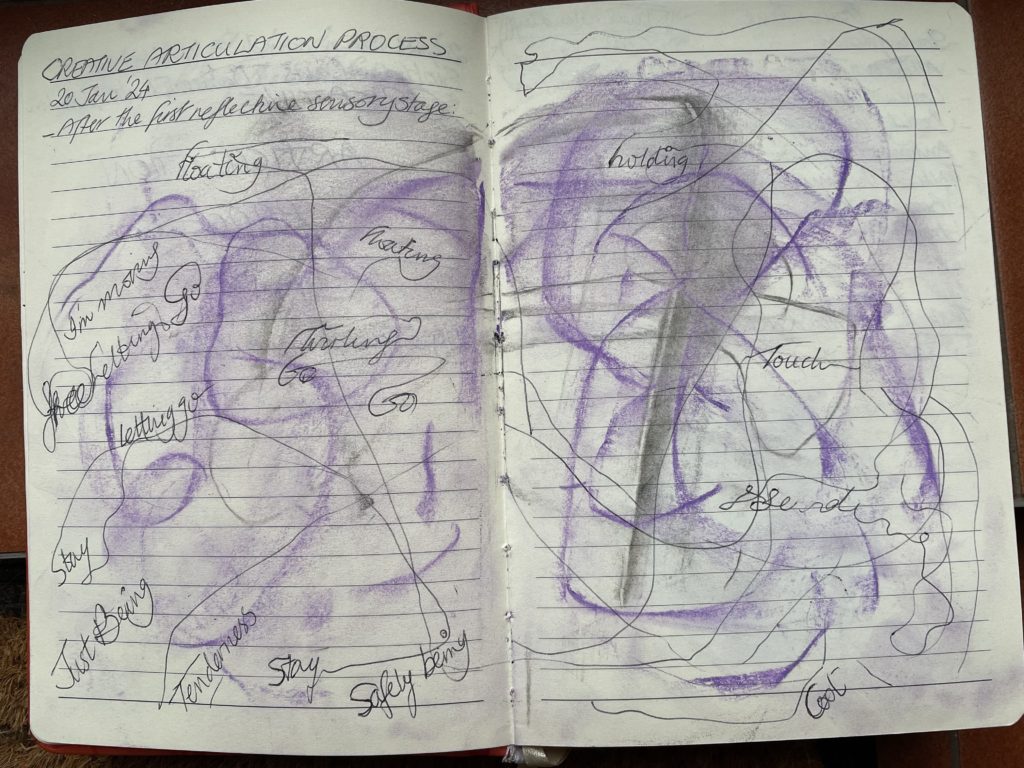
One task was to create a large dot on the page and attend to it by looking at it and exploring what happens in the body. Attend to the dot and notice how you attend to the dot. Then making any marks or/and use words to describe what you feel. See CAP-Image2
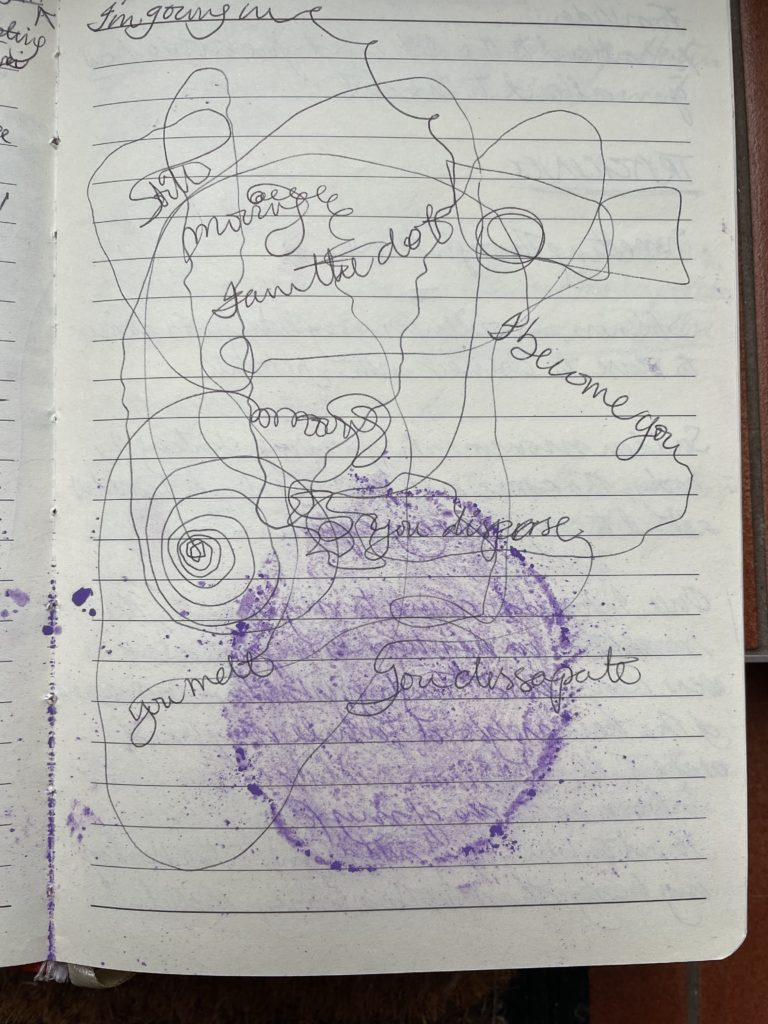
Tracking: Follow the ‘impulse’ – Noticing and following the impulse before rationalising it, Allowing the body to guide, without interpreting or judging
Make movements and track the movements. I noticed that in small movements created a stillness that my body found it easier to sense, connect and track my body’s movement. Sudden movements, jumping, shaking my arms and body, while sensory, I couldn’t attend to the sensory experiences well. Once I stopped and came back to my breath, the sensations in my hands in particular, were very vivid. Tingling, vibration, movement in the nerves, blood, while my hands were still. I was aware of movement in my body while still. I also was aware of my feet. I had to bring my attention to the reset of my body and chest voluntarily. It didn’t happen naturally, instinctively. I intentionally brought my attention to my chest so I could notice how it felt. How I felt.
In the discussion we were told to ‘delay interpretation’. To stay with a sensation, try to get to the quality of a feeling, before attending to it. Not judging it. This is a practice that strengthens with time.
Focusing
Focusing works best as an embodied experience, thinking of the edge
In a 5 minutes task, sitting in pairs, one performed/attended to the body and the other was a witness. The performer sat/lied down/stood as preferred and focused on how she felt and used words aloud to describe the feeling, the witness repeated the words back, without commenting. The performer could change the word if it didn’t sound right to hear it back, as sensations change, they are not static. After they swapped, they each listened to each other about how it felt to be a witness, again without the other commenting or interpreting the witness’s feelings.
The task was then repeated with the witness listening in silence, without repeating the words. After swapping, come together and each speak of he own experience.
Situating
In a task we were asked to find a space in the room, situate ourselves there and as you move, notice what seems to become a thing of interest, the impulse that arises in you. Begin to track it without naming it, just feel it, move around and see if/how it changes for you. Then in whatever form feels right for you (words/drawing/movement/sound etc.), articulate tracking that impulse and how it felt.
I moved my feet on the floor, without lifting them and began to sense the textures of the wooden floor under my feet. I then became aware of the ridges between the floor boards. See CAP-Image3
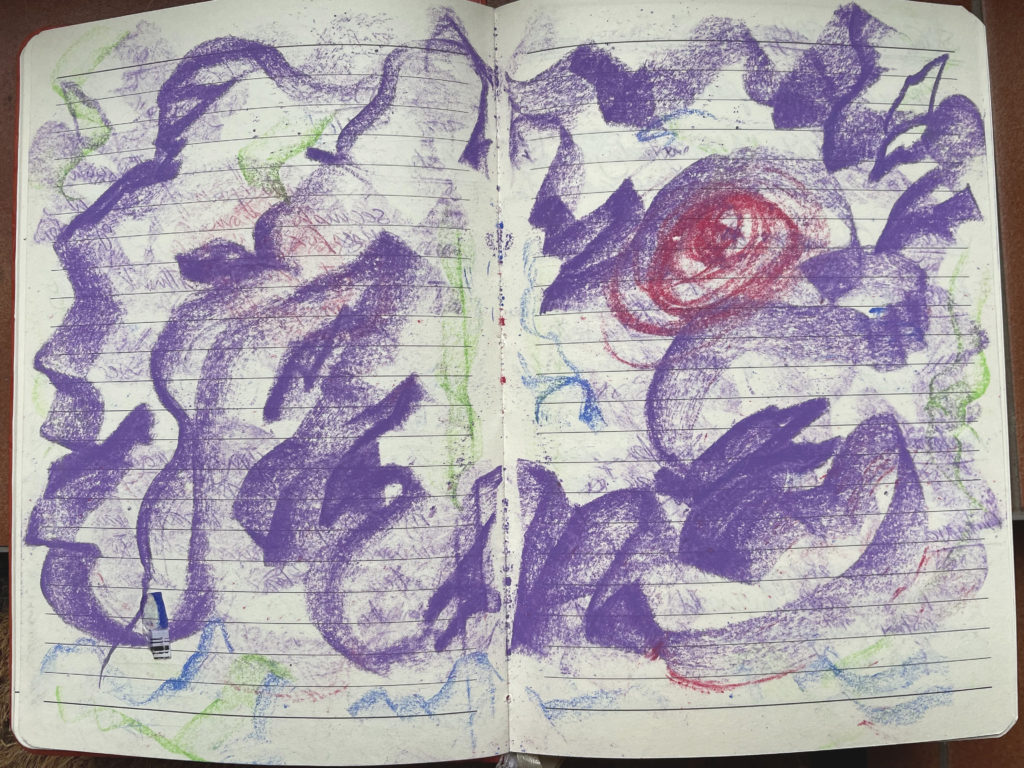
There were then a series of activities of 4 minute of moving followed by 4 minutes of writing about it:
Opening: Sliding my skin, palms of my hands, back of my hand, tips of my fingers, tips of my finger nails, turning the palm of the back if y hand, knuckles sliding on the hard wooden floor, sensing the grooves, tracking the length of the grooves, gentle, smooth around them, sliding, the small jagged edges, ENCOUNTERS, I slide my hand, palms across the vertical pieces, again and again, feeling the jaggedness of the grooves, I encounter the page.
Situating: Feeling the floor with my whole body, feet in socks, sliding across the floor, hardness softens by the smooth sliding if my feet, then my legs, my arms, my torso, my face, my forehead, glide along, slowly, a twinge of pain in my hip, a strain in my neck, taste of coffee in my mouth, my tongue tingles, rigid, jaw clinched, sliding across the wooden slats, moving on railway tracks, glide, softness, tingling, when I slow down the movement to almost stopping, my thighs touching, caressing, CARESSING the floor I become the floor.
Delving: I move feel the grooves, the jagged sense of them against my fingers, my palms, my face,. My hand feels every groove, my forehead feels a smooth surface. SMOOTH. I sit, still, my hands still, palms on the grooves, the jaggedness of them disappear. All I sense is the hard floor, smooth floor. SURPRISE. The jagged sense disappeared, it has been absorbed by my fingers, in their stillness. Now, without movement, I am aware of my body, my chest, my breath, the movement contained, soft, my stomach’s gentle rising and falling. My attention has shifted to my own body, the inner movements. Resting in the moment.
RAISING: Fingernails, hard , ice-skating on the floor. Standing, my feet in socks, softly sense the grooves between the wooden boards, my body gently swyas, I lift one foot, sway my hips, they feel rigid, I lower the arch of my foot, then heel, the knee bends as I sway and raise the other foot and again sway. Toes, arch, heel, feel, touch the floor, light sensation of the grooves on the floor.
DAY TWO
Tracking: Be still in the body in whatever pose and track/write about it immediately afterwards:
I feel the floor, hard against my soft body. I’m lying on the floor, Shavasna pose. My breath, cool, moves down, cool along the nostrils, like a river, runs down my throat, the back of my throat, my chest, ribcage rises, fills. I feel lifted, the wave of the breath recedes, it travels back to where it came from, warm, softening me, my body eases, like a silent contented sigh, it leaves my body quietly, gently, like a tender stroke. And the new breath arrives, without warning, without a nudge to restart. My fingertips tingle, my toes feel a lift, movement, is it the blood moving through me? I feel my hands, feet, calves, forearms, knees, elbows, and so the soft lifting, a buzzing, humming, pulsating, quietly, as I exhale.
It is a remembering, I close my eyes, I revisit the sensations. My pen moves as I write, as I remember, as I relive. A gentle transcendence, moving from the felt to the remembered, the pen transcribed, the pen a becoming, not only noting, but letting the pen, the apparatus become part of the embodiment.
>>>This resonates with Susan Stuart’s ‘enkinaesthetic articulation’, enkinaesthetic entanglement’, and Karen Barad’s ‘agential intra-action’ and ‘entanglement’<<<
Reflection on my experience of writing about the activity:
I found it far easier to find works to articulate how I felt, and got lost in the process by using words with intonations that complemented the movement and how it felt. I felt natural, the worlds flowed with the movements. Describing harder movements, jagged movements, pressure and painful struggles in movements, I found equally challenging to describe.
I am curious about the distinction between sensing and feeling, they often interchange in language. Can the hearer really know which is meant? Does it depend on their resonance with the gesture, the sense, the feeling?
It is all very profound and needs time to decompress afterwards. Time to rest the sense, Particularly if you are highly sensitive (as I am).
Activity: Read my written reflection and notice what arose, if I can render it/delve into it further. Look for what arises. How can you manifest it?
Anatomizing: Manifest what arose in different iterations, shift to a different perspective
I used charcoal and coloured pastels to draw and allowed my hand to guide and manifest what arose in feeling the floor.
CAP-Image 4 manifests feeling the jagged edges of the floor boards and the jagged movements
CAP-Image 5 manifest the softer flow of moving my body against the floor
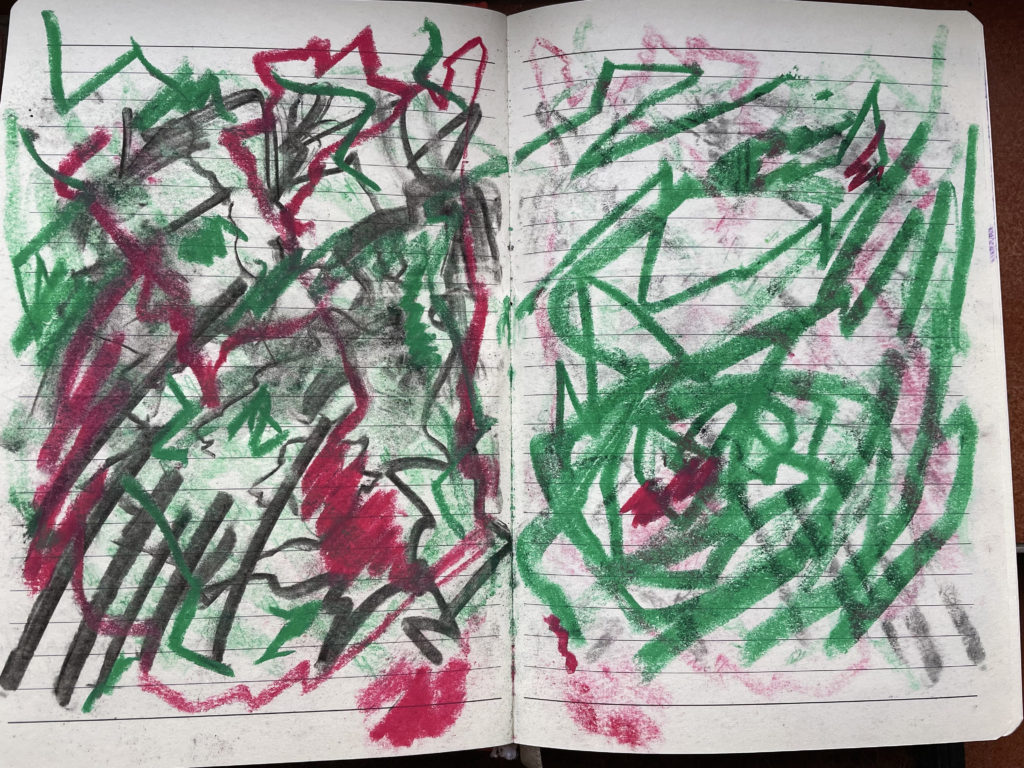
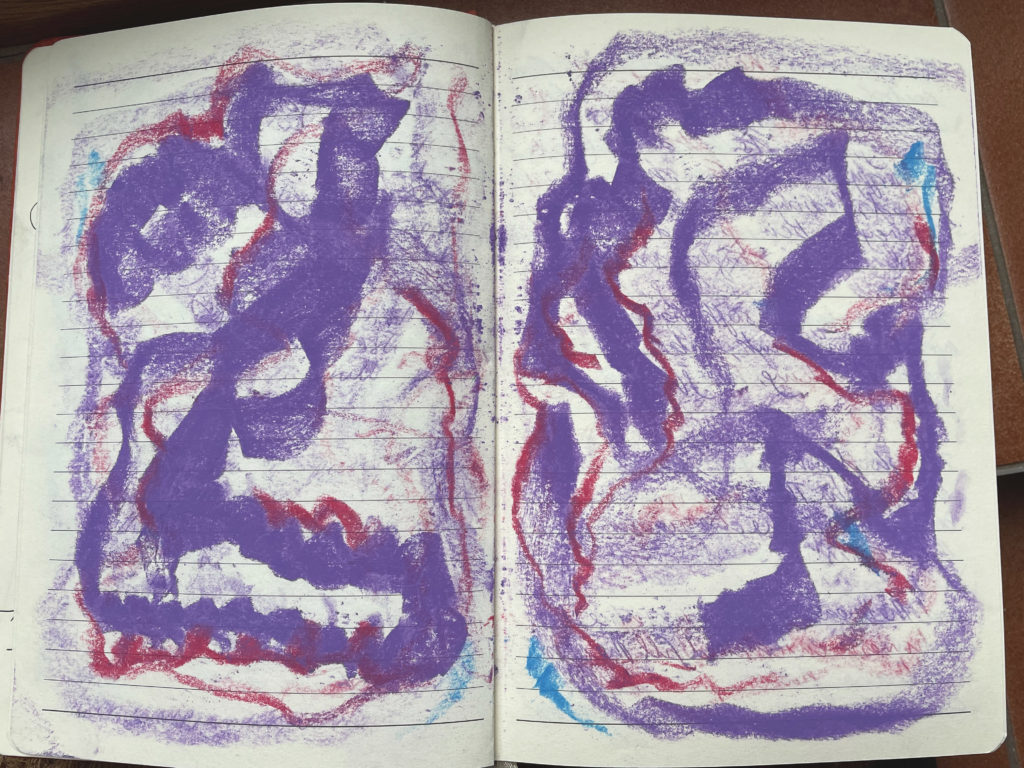
Reflection on anatomizing:
The oppressor, the hands that press, firm, control, strength, force, weight, drive.
The body, the parts that are subjected to the oppressor, the force, moved, pulled, pushed, bearing the burden, feeling the weight, being pulled, being pushed, pressure, heat, caught, vulnerable.
The many layers, soft, hard, strong, weak, dominant, submissive, pulling, pushing, being pulled, being pushed. ]the blood continues to pump, to move, to travel in the limbs, in the hard and the soft, the dominant and ethe submissive.
And the breath, quietly, unnoticed, continues to enter and fill the chest, and leave, flattening the chest. Enter, leave, enter, leave, enter, exit, enter, exit.
The oppressor rests, the grip is softened, the weight lifted, stillness.
The blood continues to pump, to move, to travel in the body, never ending journey.
The breath carries on, in, out, in, out, in, out. Enter, expand, exit, deflate, enter, exit, enter, exit, enter, exit.
The spectacle took place, The oppressor was the oppressed. All is still now. Just the blood keeps on travelling, the breath keeps visiting, over and over and over and over and………………………………………………………………………………………….
Drawing the experiences, from different angles, then writing about the experiences, My body, senses, were witnessing the acts. What did they feel now? While drawing, I was an act of remembering, re-living, the softness of the marks, the jagged lines, mirroring the experiences of my body.
Outwarding: Share the experience with others (I used words)
Multiplicity
We are multi-layered being.
Our senses, we sense the world in a multi-layered way
Moving, a moving agent, moves not only of that it exists in. I move my arm, my hand, I also move the air around my arm, my hand.
We exist within layers,
We are entangled
My pen moves, my hand drives that movement, The ink on the page moves from the pen to the page, the page moves with the pressure of the pen, with the pressure of my hand,
The words appear, in shapes, forms,, there is movement as they appear on the page,
The blood moves in my hands
The breath rises and falls, enters and exits my body
Everything in movement
The pen becomes embodied
The ink becomes embodied
All tangled, breath, blood, hand, pen, ink, page, the air that is quietly parted and moved by the page, All tangled, All intra-ac ting
All part of the same action,
Same process,
They are, in the process,
Fused, there is a becoming into one while in motion
The sense merge,
The pen, an extension of the body, the ink, the page, extensions of the body,
Embodied articulations
The pen, the ink, the page, the air, sense the hand that moves them, animates them
It’s a Dance!
Traces of the body left on the pen, on the page.
I leave a trace of me on the page.
The act. I come to life, long after the act, on the page.
There is no end here. The act is relived, again and again, as it is read.Time no longer a container.
About CAP
The Creative Articulations Process (CAP) has been co-devised by Prof. Vida Midgelow and Prof. Jane Bacon.
CAP is the process of bringing the inner experiences to the outer through language.
The practice is multifaceted and rhizomatic. It is described as:
- A model with accompanying strategies for the development of PaR or reflexive practice more generally
- Bringing the tacit into consciousness … making the implicit more tangible. Working with dual awareness.
- To be used within, as or alongside your creative practices – helping you to unfold, discern and deepen.
- A method through you may become more articulate in/as your moving/writing creative researching self
It consists of six facets (which are not isolated but rhizomatic and intertwines):
- Opening: Giving space and time
- Situating: (What I know today about) what brings me here, where I am
- Delving: (I wonder) what interests me…
- Raising: working to enrich/explore/render that I am interested in – know more of what I am working with…
- Anatomizing: working to expand/broaden/trial/clarify my practice
- Outwarding: finding a shape or form in a moment of fruition that (might) find a place in the ‘world’ ….. newly noting (perhaps) future directions/spaces/times that draw me
A rhizomatic practice
- The Preparations, Ground Form and Expanded Form can each stand apart, whilst equally reinforcing and supporting each other.
Preparation:
- Embodied Knowing
- Attending
- Tracking and discernment
- Dual Awareness
- Languaging
The Ground Form is a (daily) 1 hour practice in which you practice entering and noticing the facets and the shifting of modalities. It is a repeated embodied enquiry followed by writing
The Expanded Form can be used and applied within your creative process/life. Here the facets might be purposefully activated or just noted. You may spend a prolonged period in embodied enquiry before writing.
Some of the underlying skills used and developed in CAP are found in capacities for:
- Attending
- Dual awareness
- Embodied and material knowing
- Languaging and writing
- Tracking
- Discernment
- Shifting across modalities (moving to writing to drawing, etc)
Drawing upon skills that might also be found in:
- Accessing the felt sense (see ‘focusing’) and our somatic markers
- Improvisatory processes
- Authentic movement (See Bacon Authentic Movement: A field of practices’, guest edited special issue of Journal of Dance and Somatic Practices, 7:2, 2015)
- Somatic education, mindfulness and therapies
- Choreography, arts and craft practices which emphasise material process and ‘trusting’ the process
- Practice as Research methods for movement based research
- Movement analysis / description
- Embodied and creative approaches to writing
…..Amongst others
